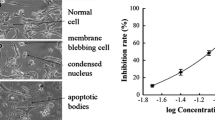Summary
This study examined the effect of copper ions on the proliferation of hepatic stellate cells (HSCs) and the role of oxidative stress in this process in order to gain insight into the mechanism of hepatic fibrosis in Wilson’s disease. LX-2 cells, a cell line of human HSCs, were cultured in vitro and treated with different agents including copper sulfate, N-acetyl cysteine (NAC) and buthionine sulfoximine (BSO) for different time. The proliferation of LX-2 cells was measured by non-radioactive cell proliferation assay. Real-time PCR and Western blotting were used to detect the mRNA and protein expression of platelet-derived growth factor receptor β subunit (PDGFβR), ELISA to determine the level of glutathione (GSH) and oxidized glutathione (GSSG), dichlorofluorescein assay to measure the level of reactive oxygen species (ROS), and lipid hydroperoxide assay to quantify the level of lipid peroxide (LPO). The results showed that copper sulfate over a certain concentration range could promote the proliferation of LX-2 cells in a time- and dose-dependent manner. The effect was most manifest when LX-2 cells were treated with copper sulfate at a concentration of 100 μmol/L for 24 h. Additionally, copper sulfate could dose-dependently increase the levels of ROS and LPO, and decrease the ratio of GSH/GSSG in LX-2 cells. The copper-induced increase in mRNA and protein expression of PDGFβR was significantly inhibited in LX-2 cells pre-treated with NAC, a precursor of GSH, and this phenomenon could be reversed by the intervention of BSO, an inhibitor of NAC. It was concluded that copper ions may directly stimulate the proliferation of HSCs via oxidative stress. Anti-oxidative stress therapies may help suppress the copper-induced activation and proliferation of HSCs.
Similar content being viewed by others
References
Pfeiffer RF. Wilson’s disease. Handb Clin Neurol, 2011,100:681–709
Ala A, Walker AP, Ashkan K, et al. Wilson’s disease. Lancet, 2007,369(9559):397–408
Friedman SL. Hepatic stellate cells: Protean, multifunctional, and enigmatic cells of the liver. Physiol Rev, 2008,88:125–172
Friedman SL. Mechanisms of hepatic fibrogenesis. Gastroenterology, 2008,134(6):1655–1669
Wan XH, Li YW, Luo XP. Curcumin attenuated the lipid peroxidation and apoptotic liver injury in copper-overloaded rats. Chin J Pediatr (Chinese), 2007,45(8): 604–608
Schmittgen TD, Zakrajsek BA, Mills AG, et al. Quantitative reverse transcription-polymerase chain reaction to study mRNA decay: comparison of endpoint and real-time methods. Anal Biochem, 2000,285(2):194–204
Lin J, Chen A. Activation of peroxisome proliferator-activated receptor-γ by curcumin blocks the signaling pathways for PDGF and EGF in hepatic stellate cells. Lab Invest, 2008,88(5):529–540
Zheng S, Yumei F, Chen A. De novo synthesis of glutathione is a prerequisite for curcumin to inhibit hepatic stellate cell (HSC) activation. Free Radic Biol Med, 2007,43(3):444–453
Sun YL, Zhao JM, Li WS, et al. Clinical pathological features of child Wilson’s disease and the mechanism of hepatic fibrosis. Med J Chin PLA (Chinese), 2005,30(4): 300–302
Xu L, Hui AY, Albanis E, et al. Human hepatic stellate cell lines, LX-1 and LX-2: New tools for analysis of hepatic fibrosis. Gut, 2005,54(1):142–151
Tian Y, Yang X, Jiang YF, et al. 4 cases of fulminant Wilson’s disease: the clinical features and treatments. Chin J Hepatol (Chinese), 2010,18(9):717–718
Merle U, Schaefer M, Ferenci P, et al. Clinical presentation, diagnosis and long-term outcome of Wilson’s disease: a cohort study. Gut, 2007,56(1):115–120
Campbell JS, Hughes SD, Gillbertson DG, et al. Platelet derived growth factor C induces liver fibrosis, seatosis, and hepatocellular carcinoma. Proc Natl Acad Sci USA, 2005,102(9):3389–3393
Guimarães EL, Franceschi MF, Grivicich I, et al. Relationship between oxidative stress levels and activation state on a hepatic stellate cell line. Liver Int, 2006,26(4): 477–485
Galli A, Svegliati-Baroni G, Ceni E, et al. Oxidative stress stimulates proliferation and invasiveness of hepatic stellate cells via a MMP2-mediated mechanism. Hepatology, 2005,41(5):1074–1084
Urtasun R, Nieto N. Hepatic stellate cells and oxidative stress. Rev Esp Enferm Dig, 2007,(4):223–230
Author information
Authors and Affiliations
Corresponding author
Rights and permissions
About this article
Cite this article
Xu, Sq., Zhu, Hy., Lin, Jg. et al. Copper ions stimulate the proliferation of hepatic stellate cells via oxygen stress in vitro . J. Huazhong Univ. Sci. Technol. [Med. Sci.] 33, 75–80 (2013). https://doi.org/10.1007/s11596-013-1074-2
Received:
Published:
Issue Date:
DOI: https://doi.org/10.1007/s11596-013-1074-2




